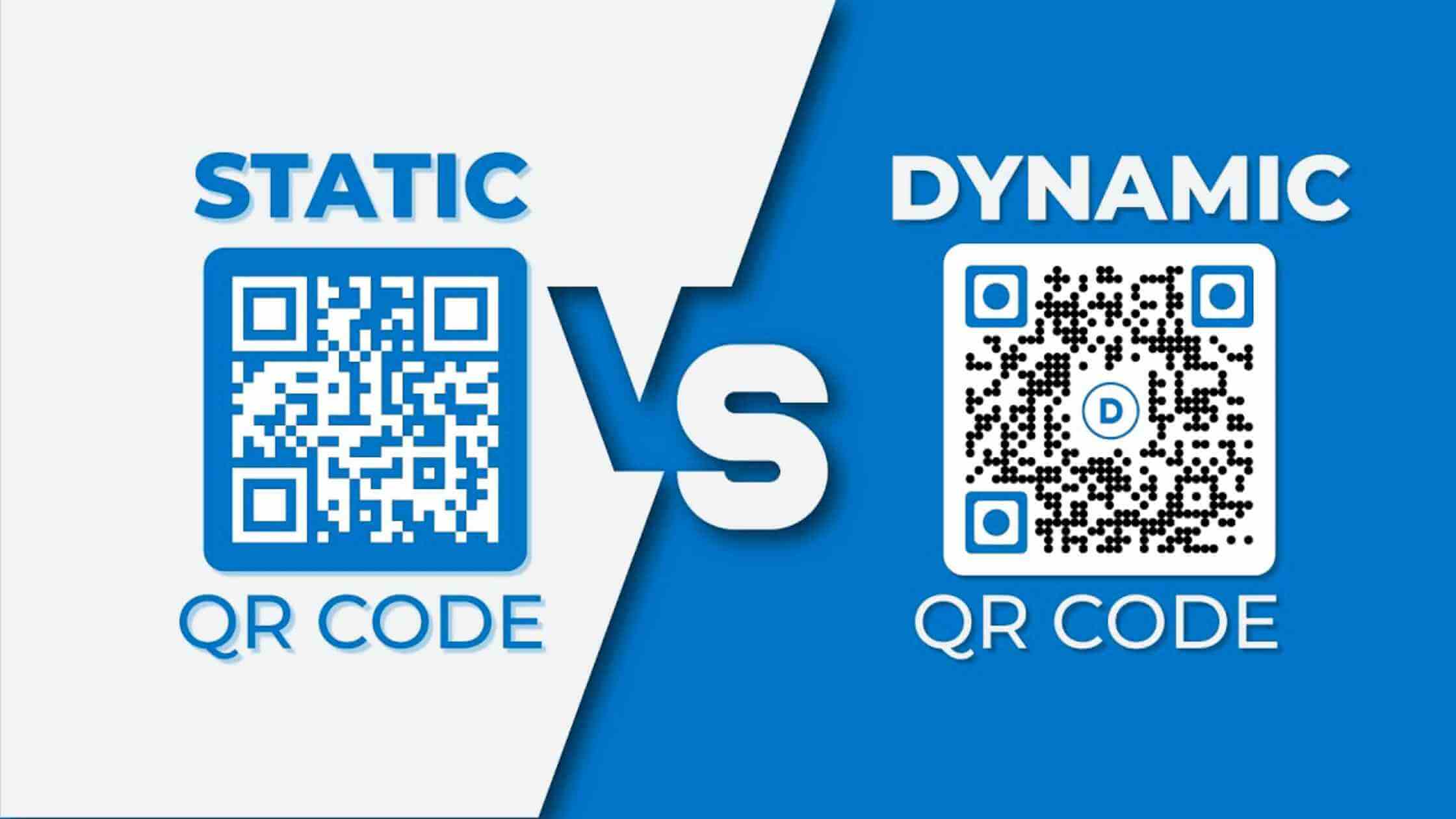Introduction
The static vs dynamic QR code debate can be confusing and challenging, especially for first-time users who might find them look alike.
In reality, each QR code type serves different purposes with unique features and functions.
Beyond the fancy footwork, both static and dynamic QR codes have their strengths and weaknesses, like two sides of a digital coin.
Understanding the distinctions between them not only unlocks a world of possibilities but also empowers users to make informed choices.
Difference Between Static and Dynamic QR Codes
Static QR Codes

What are Static QR Codes?
Static QR codes are QR codes that contain fixed information and do not change over time. QR stands for “Quick Response,” and these codes can be scanned using a smartphone or a QR code reader to quickly access information. In the case of static QR codes, the data encoded in the QR code remains constant.
How do Static QR Codes Work?
Static QR codes work by encoding data in a grid of black squares arranged on a white background in a specific pattern. When you scan a static QR code using a QR code reader or a smartphone camera, the encoded information is extracted and processed.
Functionality
Static QR codes can encode various types of information, including URLs, plain text, phone numbers, and email addresses. They act as direct links, taking users to the encoded content with a single scan.
It’s important to note that the functionality of a static QR code is fixed once it is generated. Any updates or changes to the encoded information require creating a new QR code.
Static QR Code Advantages
Static QR codes offer several advantages in various contexts, making them a popular choice for certain applications:
- Simplicity and Ease of Use:
Static QR codes are straightforward to generate and use. The process involves encoding fixed information, making it easy for individuals and businesses to create and share QR codes without the need for frequent updates.
- No Ongoing Maintenance:
Once a static QR code is generated, there is no ongoing maintenance required. The encoded information remains constant until a new QR code is created with updated content. This simplicity is advantageous for scenarios where stability and consistency are key.
- Cost-Effective:
Creating static QR codes is often more cost-effective, especially for applications where the information does not change frequently. There is no need for a dynamic system to manage and update the content within the QR code.
- Offline Accessibility:
Static QR codes work without the need for an internet connection. This makes them suitable for scenarios where users may not have constant access to the internet, such as in printed materials or offline environments.
- Compatibility:
Static QR codes are widely compatible with most QR code readers and devices. As they contain fixed information, there is no need for real-time interaction or dynamic content updates, ensuring broad compatibility across different platforms and devices.
Static QR Code Limitations
While static QR codes offer simplicity and stability in certain use cases, they also come with limitations that may be important to consider in specific scenarios:
- No Real-Time Updates:
One of the primary limitations of static QR codes is that the encoded information remains fixed after generation. Any updates or changes to the content require the creation of a new QR code. This can be impractical for applications requiring real-time or frequently updated information.
- Limited Interactivity:
Static QR codes provide a one-way interaction, delivering information to the user. They are not suitable for scenarios where dynamic or interactive content is necessary, such as surveys, live tracking, or real-time promotions.
- Space Limitations:
Static QR codes may have limitations in terms of the amount of information they can store, especially if used for complex data types. This could be a constraint when encoding large amounts of text, multimedia, or detailed information.
- Less Suitable for Marketing Campaigns:
In marketing campaigns where tracking and analytics are crucial, static QR codes may not be the best choice. Dynamic QR codes can provide insights into user interactions, such as the number of scans, location data, and time of access.
- Security Concerns
While the fixed nature of static QR codes can be considered a security advantage in certain contexts, it may also be a limitation. If sensitive information is encoded, the lack of real-time control could pose security risks if the information becomes compromised.
Use Cases and Applications
Static QR codes find applications in various fields due to their simplicity, ease of use, and stability. Here are some common use cases and applications of static QR codes:
- Marketing and Advertising:
Static QR codes are extensively used in marketing materials, enabling quick and convenient access to promotional websites, product details, or special offers.
- Business Cards:
Including a static QR code on business cards simplifies the process of saving contact information, enhancing networking efficiency.
- Product Packaging:
Static QR codes on product packaging provide consumers with instant access to user manuals, warranty information, and additional product details, contributing to a positive customer experience.
- WiFi Network Setup:
Simplifying the configuration of WiFi networks, static QR codes make it easy for users to connect to the specified network without the need for manual entry of credentials.
- Restaurant Menus:
In the hospitality industry, static QR codes on menus link customers to online menus, special promotions, or the restaurant’s website, providing a seamless and interactive dining experience.
These applications showcase the versatility and practicality of static QR codes in various sectors, emphasizing their ability to streamline information access and enhance user engagement.
Dynamic QR Codes

What are Dyanmic QR Codes?
Dynamic QR codes are QR codes that can be modified or updated after they have been generated. Unlike static QR codes, which contain fixed information, dynamic QR codes allow for flexibility in the encoded content.
The ability to change the data within the QR code without altering the code itself makes dynamic QR codes suitable for applications where real-time updates or frequent changes are required.
How do Dynamic QR Codes Work?
Dynamic QR codes work by allowing the encoded information to be changed or updated after the QR code has been generated.
The process involves the use of a QR code management platform or service that facilitates the creation, tracking, and modification of dynamic QR codes.
Functionality
The functionality of dynamic QR codes revolves around their ability to adapt and change the linked content dynamically. The functionality of dynamic QR codes provides a powerful tool for businesses, marketers, and individuals who need to manage and update information efficiently in real-time. This flexibility makes dynamic QR codes suitable for a wide range of applications across different industries.
Dynamic QR Code Advantages
Dynamic QR codes offer several advantages over static QR codes, making them a preferred choice in various applications. Here are some key advantages of dynamic QR codes:
- Real-Time Content Updates:
Dynamic QR codes allow users to update the linked content in real-time. This is particularly beneficial for scenarios where information changes frequently, such as in marketing campaigns, promotions, or event details.
- Versatility and Adaptability:
Dynamic QR codes are highly versatile and adaptable. The same QR code can be repurposed for different content, making them suitable for multi-purpose use over time without the need for new physical codes.
- Cost Savings in Printing:
For applications where QR codes are included in printed materials, using dynamic QR codes can save costs. Updates to the linked content can be done digitally, eliminating the need for reprinting materials with updated QR codes.
- Analytics and Tracking:
Dynamic QR code services often come with built-in analytics features. Users can track metrics such as the number of scans, user demographics, devices used for scanning, and the time and location of scans. This data provides valuable insights for assessing the performance of QR code campaigns and user engagement.
- Enhanced Security with Password Protection:
Some dynamic QR code services offer the option to add password protection to the linked content. This provides an extra layer of security, ensuring that only users with the correct password can access sensitive or private information.
Dynamic QR Code Limitations
While dynamic QR codes offer many advantages, they also come with certain limitations and considerations. Here are some of the potential drawbacks of dynamic QR codes:
- Dependency on Internet Connection:
Dynamic QR codes typically require an internet connection to access the linked content. If users are in areas with poor or no connectivity, they may not be able to access the information, limiting the effectiveness of the QR code.
- Service Reliability:
The functionality of dynamic QR codes is dependent on the reliability and availability of the QR code management service or platform. Downtime or disruptions in service can impact users’ ability to access the linked content.
- Service Costs:
While basic dynamic QR code functionality may be free, some services may involve subscription fees or costs for advanced features. Businesses or individuals with specific needs may incur additional expenses, potentially affecting the overall cost-effectiveness.
- Potential for Exploitation:
Dynamic QR codes can be susceptible to exploitation if the linked content is not adequately secured. Malicious actors may attempt to replace the content with harmful or misleading information, posing risks to users.
- Print Quality and Scanability:
The scanability of dynamic QR codes, especially when printed, can be affected by factors such as print quality, size, and placement. If the QR code is too small, printed in low quality, or placed in challenging locations, users may have difficulty successfully scanning the code.
These limitations highlight considerations related to connectivity, reliability, cost, security, and practical usability that users and businesses should keep in mind when deciding whether to use dynamic QR codes for their specific applications.
Use Cases and Applications
Dynamic QR codes find applications in various scenarios where the ability to update information in real-time is essential. Here are the top five use cases and applications for dynamic QR codes:
- Marketing Campaigns:
Dynamic QR codes are widely used in marketing campaigns where promotional content, offers, or discounts can be updated in real-time. Marketers can adapt campaigns based on user responses and engagement metrics.
- Event Promotions and Ticketing:
Dynamic QR codes are effective for promoting events and ticketing. Event details, schedules, or ticket availability can be updated dynamically, providing attendees with the latest information.
- Product Packaging and Labels:
Dynamic QR codes on product packaging or labels allow manufacturers to update users on recalls, provide links to user manuals or instructional videos, and share additional product information without the need for reprinting.
- Retail and Point-of-Sale (POS):
In retail environments, dynamic QR codes can be used for promotions, loyalty programs, and changing discounts. Retailers can adapt their offerings based on inventory levels, seasonal changes, or marketing strategies.
- Educational Materials:
In educational settings, dynamic QR codes on textbooks, posters, or teaching materials can link to updated online resources, videos, or additional learning materials. This enables educators to provide the latest content to students.
These use cases demonstrate the versatility of dynamic QR codes in adapting to changing information needs across various industries. The real-time update feature of dynamic QR codes makes them well-suited for scenarios where information changes frequently and where staying current is crucial for user engagement and effectiveness.
Choosing the Right QR Code Type
So, who wins the QR code crown? Well, it’s not a zero-sum game. The best choice depends on your needs and budget. Use this handy table as your decoder ring:

Remember, choosing the right QR code is like picking the perfect pair of shoes for your cosmic journey. Consider your destination, terrain, and personal style (okay, maybe not the shoe part). Are you a casual stroller seeking simplicity, or a data-driven adventurer craving flexibility?
Consideration of specific needs, budget constraints, and campaign goals is crucial when choosing between static and dynamic QR codes. Tailor your choice to align with the desired outcome and target audience.
Best Practices for QR Code Implementation
Once you’ve chosen your code, mastering its implementation is key. Here are some best practices to ensure your portals open smoothly:
Design Considerations
When creating QR codes, ensure they are visually appealing and easily scannable. Consider factors such as color contrast, size, and the incorporation of a clear call to action.
Error Correction and Data Redundancy
Choose an appropriate error correction level based on the environment where the QR code will be scanned. Additionally, incorporate data redundancy to enhance error resilience.
Testing and Quality Assurance
Before deploying QR codes, conduct thorough testing across various devices and scanning apps. Regularly monitor and update dynamic QR codes to ensure optimal performance.
Final Thoughts
In the static vs dynamic QR code debate, the key takeaway is simple: static for simplicity, dynamic for flexibility.
Embrace the power of QR codes by experimenting with both types to find the best fit for your specific needs.
As technology continues to evolve, understanding the dynamic duo of static and dynamic QR codes becomes indispensable.
Remember, static codes offer simplicity and permanence, while dynamic codes dance with flexibility and data. Choose the right tool for the job, embrace best practices, and watch your QR code campaigns soar.



